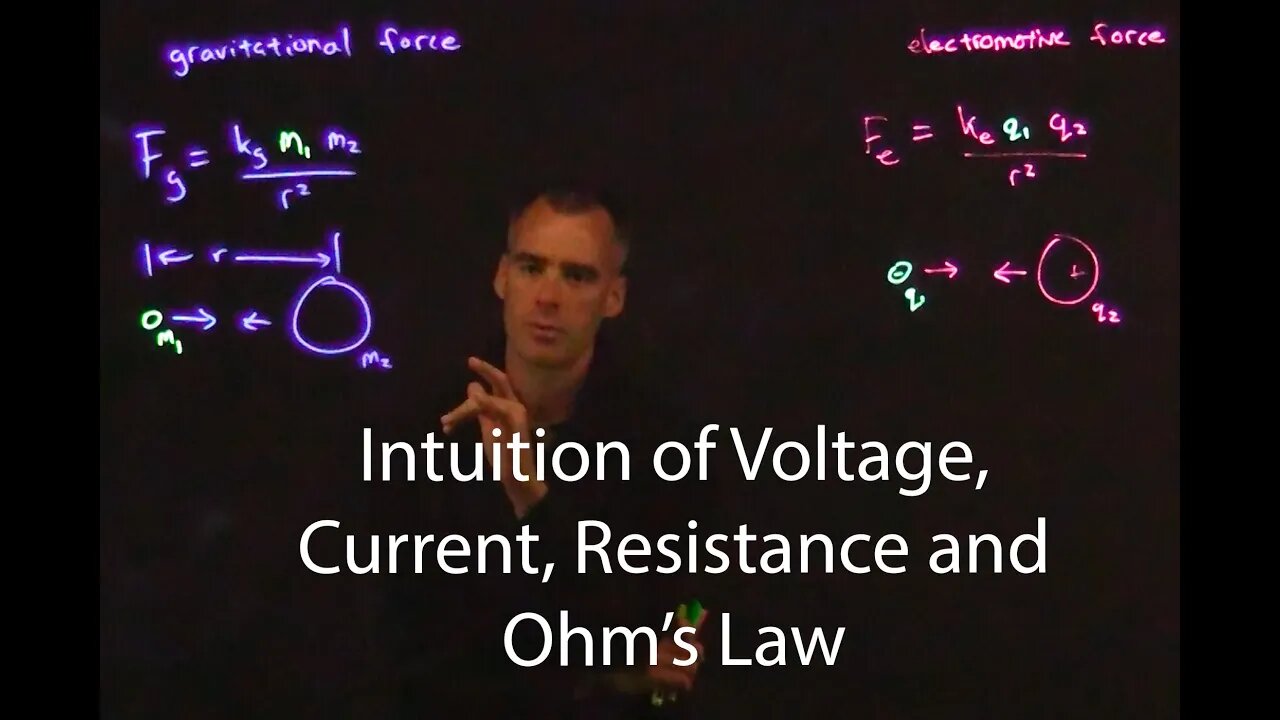Premium Only Content

Intuition behind Voltage, Current, Resistance and Ohms Law
Overview:
Electromagnetic force
The electromotive force is one of the four fundamental forces of nature
The one you may be more familiar with is the gravitational force, where two objects with mass1 and mass2 attract to each other based on the equation
Where r is distance between them and k_g is the gravitational constant
Perhaps you never thought of this but it was very puzzling to Newton and others of his time how two objects could interact via this attractive force when there was nothing actually connecting them (like 'ether'), just empty space. Newton didn't have an explanation for this, and endured much criticism for it, but he was right nonetheless.
The elctromagnetic force is very similar actually, the main differences being it is first of all a stronger force, and that it depends not on the mass of the objects but their positive or negative charge.
Where r is distance between them, q1 and q2 are the charges of the objects, and k_g is Coulomb's constant. So the attraction is based on the charge of the objects and the distance between them.
Transition: This similarity between the gravitational and electric forces allows us to make some analogies that may help you understand
Voltage
There is something known as a 'gravitational potential' that defines how much energy or work is required to, say, get to a certain point above the earth. So for example, the gravitational potential 10 feet above the ground is higher than the gravitational potential at ground level, since an object above the ground has higher 'potential energy' than an object on the ground.
THe potential energy of an object above the ground is based on it's mass, but the 'gravitational potential' is basically this energy regardless of the mass, so we divide by the mass to get it. You would need background in calc3 (multivariable calculus) to show this more precisely, but the gravitational potential between two points would be
where dividing by m gets rid of the dependence on the mass of the object, and running the calculus you get more specifically
so it would lead to this type of graph of, say the gravitational potential around the earth.
The correllary to this on the electric side is the 'electric potential'. It is essentially the same thing as the 'gravitational potential', except remember that the gravitational force equation was based on mass, while the electrical force equation was based on charge. So in this case we divide by the unit charge to define this elecrtic potential based on one object's charge regardless of the charge of the object at a distance r away.
So using this similarity with gravity, we can consider the analogy between electric components and a water system.
Imagine we have a water tank that is held above the ground level. The water is at a higher elevation, which gives it more 'potential energy'. It therefore exerts a force on the water in the pipes below it, giving it pressure to push the water through where it is needed.
If the valve in your house is closed, no water is flowing, but there is still pressure on the valve so that if you open it the water will come through
This is very similar to voltage in a circuit like this:
The + side of the 9 V source is akin to the water at the higher elevation with greater potential, and the – side of the 9 V source is like the 'ground' level with less potential, so there is 'pressure' for electrons to flow in the direction of current (yes, notation is actually backward, electrons actually flow from the negative source, but we'll stick with this common notation).
The resistor here can be related to, say, the pipe size in the water system.
A narrow pipe would allow less water to flow, and would be more 'resistant' to the water flowing, whereas a larger pipe would be less resistive and allow more water to flow.
Likewise in the electric circuit, the narrow pipe would be akin to a resistor of greater resistance, and the large pipe like resistor of lower resistance that allows more electron flow, or current.
If you were to measure the amount of water flowing through the pipe, you might have something like 'water mass/s' moving through a slice of the pipe
This is similar with the circuit, except remember instead of using mass we are using charge, so the current,
I
, is defined as charge per second moving through a slice of the wire,
So as you can imagine in the water pipe, the amount of matter flowing through the pipe is larger if the pipe is larger and if there is more pressure on the water
Similarly, from the electrical side, you can imagine the current is higher if the resistance is lower and the current is larger if the voltage difference between either side is higher , which is where we get one way of writing Ohms law as V=IR, which relates current, voltage and resistance in what is likely the very last thing you will remember about electrical engineering if you forget everything else.
-
 LIVE
LIVE
Dear America
10 hours agoPam Bondi Announces NEW EPSTEIN FILES + Trump's First Speech To Congress!
5,588 watching -
 LIVE
LIVE
Wendy Bell Radio
4 hours agoDemocrats Think They're Still In Charge
10,155 watching -
 42:37
42:37
Degenerate Jay
17 hours ago $1.95 earnedWhy The Wonder Woman Game Was Really Cancelled - Rejected Media
26.2K4 -
 1:04:09
1:04:09
MTNTOUGH Fitness Lab
23 hours agoEpisode cover art John Eldredge: The Future of Christian Masculinity | MTNPOD #106
4.29K1 -
 15:56
15:56
China Uncensored
19 hours agoChina Is Heading for Zero Births
9.87K18 -
 13:27
13:27
TheRyanMcMillanShow
13 hours ago $0.44 earnedZoila Frausto Western Hunt Expo 2025
12.2K2 -
 9:13
9:13
RTT: Guns & Gear
1 day ago $1.20 earnedThe ZRO Delta FKS-9 Is A Big ZERO
6.48K3 -
 3:52:05
3:52:05
Akademiks
9 hours agoDay 3/30. Drake Drops lawsuit vs iHeartMedia? Offset and Cardi Calls it Quits. 50 v Jim Jones?
85.5K9 -
 2:51:55
2:51:55
TimcastIRL
13 hours agoTrump Just FROZE ALL Ukraine Aid After Zelenskyy SCREWED Negotiations w/Viva Frei | Timcast IRL
242K92 -
 9:54:54
9:54:54
Dr Disrespect
22 hours ago🔴LIVE - DR DISRESPECT - PUBG - 5 CHICKEN DINNERS CHALLENGE!
253K28